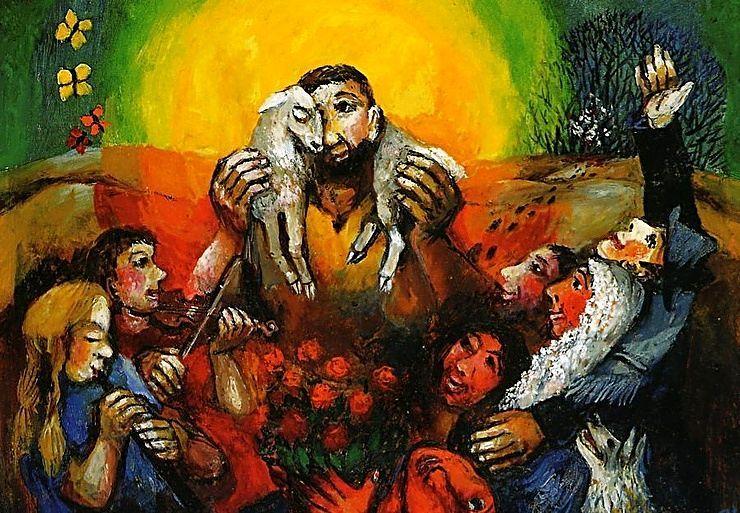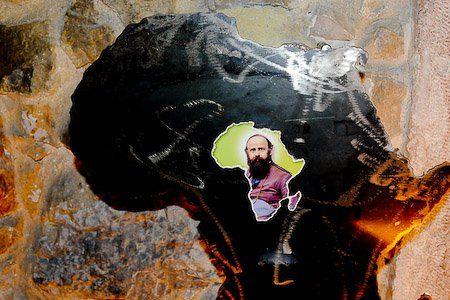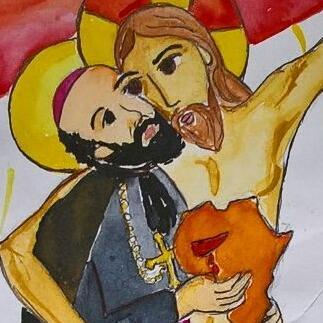Daniel Comboni
Comboni Missionaries
Institutional area
Other links
Newsletter
“He sat down opposite the treasury and observed how the crowd put money into the treasury. Many rich people put in large sums. A poor widow also came and put in two small coins with a few cents. Calling his disciples to himself, he said to them: “Amen, I say to you, this poor widow put in more than all the other con-tributors to the treasury. For they have all contributed from their surplus wealth, but she, from her poverty, has contributed all she had, her whole livelihood” (Mk 12: 41-44).
1. JESUS
“He sat down opposite the treasury and observed how the crowd put money into the treasury. Many rich people put in large sums. A poor widow also came and put in two small coins with a few cents. Calling his disciples to himself, he said to them: “Amen, I say to you, this poor widow put in more than all the other con-tributors to the treasury. For they have all contributed from their surplus wealth, but she, from her poverty, has contributed all she had, her whole livelihood” (Mk 12: 41-44).
Two coins: namely, everything. She could have shared her pos-sessions keeping some for herself: “One coin for me and one coin for the poor.” But she chose to give it all, forgetting about herself.
An example of poverty: Jesus points to the widow as an example of poverty, saying to his disciples: “See this widow? This woman has given everything… Learn from her. Learn from the poor.”
2. COMBONI
The Crucified and crucifixes
- Comboni’s spirituality is clearly marked by the characteristic of evangelical poverty: “In numerous situations of poverty, neglect and death, he finds in the crucified Christ the effective presence of the God of Life, and a multitude of brothers and sisters to love and to esteem; from his charism our commitment to live the joy of to-tal dedication, sharing the liberating power of the Gospel with the crucified victims of history” (CA ’03: 34, 35.2).
- The poor were always a challenge for Daniel Comboni, they are and will continue to be for us as well, as they spur us to be in-volved, to be present, but also challenge the style of our presence, that it may be prophetic, a sign of communion and reconciliation. In a world globalized by the politics of selfish gain, of power and influence, the challenge is to foster “a globalisation of solidarity, favouring disadvantaged peoples” (CA ’03: 26.2).
3. THE WITNESS OF THE COMBONI MISSIONARIES
- Like a hidden stone. “Many Comboni Missionaries live their consecration and missionary commitment like the hidden stone, in serenity and ordinariness. They take on the service assigned to them with enthusiasm and generosity. Others remain faithful to their people in times of war or danger” (AC 03: 16), but “we can-not deny that in our communities there are also identity problems, superficial spirituality and worldliness” (CA ’03: 22).
- With the poor. The poorest people become the specific focus of the Comboni Missionaries: minorities not yet reached by the Church and neglected by society; groups not yet sufficiently evan-gelised who live on the outer edge of poverty, through historical causes and the negative effects of globalisation and the market economy (CA ’03: 36).
- Common cause. What is the stand of the Comboni Missionary that reflects his true identity? In essence we find in the pierced Heart of Jesus, the Good Shepherd, the model, the source and the strength to give our lives to the poorest (See AC 03: 53). Like him, we do not acquire our flock with money, but we receive it from the Father; like him we are not the bearers of salvation from on high, but we live among the people, we immerse ourselves in their lives and walk with them as brothers and sisters (See AC 03: 55.3), enlightened by the Gospel and by the Lord’s Easter. Our Comboni identity spurs us “to be with and for the poor, making common cause with them and learning to read the Word and eve-ryday reality together” (CA ’03: 54.4).
4. COMBONI POVERTY AND SHARING
- Solidarity. “Through a life of poverty the missionary follows Je-sus Christ who, in spirit of solidarity with human beings, made himself poor though he was rich so that they might become rich by his poverty. The missionary chooses voluntarily the poverty of Christ, leaving everything; he shares in the common law of work, places his material possessions in common, accepts limitation and dependence on the superiors in the use and disposition of goods and follows a simple life-style in order to be free to bring the evangelising message to the poorest and most abandoned and to live in solidarity with them” (RL 27).
- Austerity. Not only does the teaching of Christ inspires us to welcome the ideal of poverty, but “the people to whom we are sent and among whom we live are God's gift, a source of conversion and a stimulus towards a life that is more evangelical and lived in solidarity with their poverty and wealth, their joys and sorrows (CA ’03: 87). The entire mission experience invites us to a con-stant journey of conversion, as we search for new styles of life, through an option for austerity and solidarity (CA ’03: 54.3).
- Simplicity. The ideal of a deep insertion in the poverty of the people has been with us for many years. With the needed institu-tional warranty of discernment, a community life characterized by greater evangelical simplicity is to be encouraged (CA ’03: 96).
- Witness. Poverty is, above all, a personal interior disposition, but sharing in the same charism brings us together to live a common style of life in view of the proclamation of and witness to the Gos-pel. “The witness of poverty is more credible when the community as such lives with an evangelical life-style” (RL 29). “The sharing of goods and of material means in community is an expression of our self-giving to Christ. In turn, it becomes an alternative pro-posal to, and a prophetic denunciation of, materialism and con-sumerism that are dominant in a globalized world” (CA ’03: 86).
- Transparency. The individualistic use of material goods is an obstacle to living a community vision of mission. To live a Com-boni rather than a personal mission is a challenge that finds an an-swer only in the real sharing of material goods, striving together to provide what is best for the mission, accepting the limitations set by local situations of poverty, sharing in the poverty of the local Church (CA ’03: 102).
5. FOR COMMUNITY REFLECTION
- Financial means often come to us in abundance, thanks to Divine Providence and the generosity of the faithful, but can easily turn into temptations whenever we derail our style of life and our loy-alty to the values of the Kingdom of God.
Shall we know how to tell when “not of bread alone does one live,” from times when people, exhausted, need help in their fol-lowing of Christ?
- The Rule of Life invites us to use our financial resources for the good of the mission, respecting the Gospel’s values (CA ’03: 101.1) in order to give an ever-clearer witness.
To witness to choices made in the light of the Gospel means that, faced by the consumerism of society, we renew our option for self-limitation in the use of economic goods, educating ourselves to self-restraint and voluntary simplicity (CA ’03: 103, 103.1).
Are our entire lives, our style, our actions, our activities, our pro-jects aimed at evangelisation and its needs? (CA ’03: 108)
- In our ranks, at least some, notice “a kind of nostalgia, an unease, a desire for change, for a more radical and authentic way of being” (CA ’03: 23).
What if these were the individuals more in tune with God’s will?
Fr. Alessandro Guarda, mccj - Fr. Teresino Serra, mccj
“He sat down opposite the treasury and observed how the crowd put money into the treasury. Many rich people put in large sums. A poor widow also came and put in two small coins with a few cents. Calling his disciples to himself, he said to them: “Amen, I say to you, this poor widow put in more than all the other con-tributors to the treasury. For they have all contributed from their surplus wealth, but she, from her poverty, has contributed all she had, her whole livelihood” (Mk 12: 41-44).
Two coins: namely, everything. She could have shared her pos-sessions keeping some for herself: “One coin for me and one coin for the poor.” But she chose to give it all, forgetting about herself.
An example of poverty: Jesus points to the widow as an example of poverty, saying to his disciples: “See this widow? This woman has given everything… Learn from her. Learn from the poor.”
2. COMBONI
The Crucified and crucifixes
- Comboni’s spirituality is clearly marked by the characteristic of evangelical poverty: “In numerous situations of poverty, neglect and death, he finds in the crucified Christ the effective presence of the God of Life, and a multitude of brothers and sisters to love and to esteem; from his charism our commitment to live the joy of to-tal dedication, sharing the liberating power of the Gospel with the crucified victims of history” (CA ’03: 34, 35.2).
- The poor were always a challenge for Daniel Comboni, they are and will continue to be for us as well, as they spur us to be in-volved, to be present, but also challenge the style of our presence, that it may be prophetic, a sign of communion and reconciliation. In a world globalized by the politics of selfish gain, of power and influence, the challenge is to foster “a globalisation of solidarity, favouring disadvantaged peoples” (CA ’03: 26.2).
3. THE WITNESS OF THE COMBONI MISSIONARIES
- Like a hidden stone. “Many Comboni Missionaries live their consecration and missionary commitment like the hidden stone, in serenity and ordinariness. They take on the service assigned to them with enthusiasm and generosity. Others remain faithful to their people in times of war or danger” (AC 03: 16), but “we can-not deny that in our communities there are also identity problems, superficial spirituality and worldliness” (CA ’03: 22).
- With the poor. The poorest people become the specific focus of the Comboni Missionaries: minorities not yet reached by the Church and neglected by society; groups not yet sufficiently evan-gelised who live on the outer edge of poverty, through historical causes and the negative effects of globalisation and the market economy (CA ’03: 36).
- Common cause. What is the stand of the Comboni Missionary that reflects his true identity? In essence we find in the pierced Heart of Jesus, the Good Shepherd, the model, the source and the strength to give our lives to the poorest (See AC 03: 53). Like him, we do not acquire our flock with money, but we receive it from the Father; like him we are not the bearers of salvation from on high, but we live among the people, we immerse ourselves in their lives and walk with them as brothers and sisters (See AC 03: 55.3), enlightened by the Gospel and by the Lord’s Easter. Our Comboni identity spurs us “to be with and for the poor, making common cause with them and learning to read the Word and eve-ryday reality together” (CA ’03: 54.4).
4. COMBONI POVERTY AND SHARING
- Solidarity. “Through a life of poverty the missionary follows Je-sus Christ who, in spirit of solidarity with human beings, made himself poor though he was rich so that they might become rich by his poverty. The missionary chooses voluntarily the poverty of Christ, leaving everything; he shares in the common law of work, places his material possessions in common, accepts limitation and dependence on the superiors in the use and disposition of goods and follows a simple life-style in order to be free to bring the evangelising message to the poorest and most abandoned and to live in solidarity with them” (RL 27).
- Austerity. Not only does the teaching of Christ inspires us to welcome the ideal of poverty, but “the people to whom we are sent and among whom we live are God's gift, a source of conversion and a stimulus towards a life that is more evangelical and lived in solidarity with their poverty and wealth, their joys and sorrows (CA ’03: 87). The entire mission experience invites us to a con-stant journey of conversion, as we search for new styles of life, through an option for austerity and solidarity (CA ’03: 54.3).
- Simplicity. The ideal of a deep insertion in the poverty of the people has been with us for many years. With the needed institu-tional warranty of discernment, a community life characterized by greater evangelical simplicity is to be encouraged (CA ’03: 96).
- Witness. Poverty is, above all, a personal interior disposition, but sharing in the same charism brings us together to live a common style of life in view of the proclamation of and witness to the Gos-pel. “The witness of poverty is more credible when the community as such lives with an evangelical life-style” (RL 29). “The sharing of goods and of material means in community is an expression of our self-giving to Christ. In turn, it becomes an alternative pro-posal to, and a prophetic denunciation of, materialism and con-sumerism that are dominant in a globalized world” (CA ’03: 86).
- Transparency. The individualistic use of material goods is an obstacle to living a community vision of mission. To live a Com-boni rather than a personal mission is a challenge that finds an an-swer only in the real sharing of material goods, striving together to provide what is best for the mission, accepting the limitations set by local situations of poverty, sharing in the poverty of the local Church (CA ’03: 102).
5. FOR COMMUNITY REFLECTION
- Financial means often come to us in abundance, thanks to Divine Providence and the generosity of the faithful, but can easily turn into temptations whenever we derail our style of life and our loy-alty to the values of the Kingdom of God.
Shall we know how to tell when “not of bread alone does one live,” from times when people, exhausted, need help in their fol-lowing of Christ?
- The Rule of Life invites us to use our financial resources for the good of the mission, respecting the Gospel’s values (CA ’03: 101.1) in order to give an ever-clearer witness.
To witness to choices made in the light of the Gospel means that, faced by the consumerism of society, we renew our option for self-limitation in the use of economic goods, educating ourselves to self-restraint and voluntary simplicity (CA ’03: 103, 103.1).
Are our entire lives, our style, our actions, our activities, our pro-jects aimed at evangelisation and its needs? (CA ’03: 108)
- In our ranks, at least some, notice “a kind of nostalgia, an unease, a desire for change, for a more radical and authentic way of being” (CA ’03: 23).
What if these were the individuals more in tune with God’s will?
Fr. Alessandro Guarda, mccj - Fr. Teresino Serra, mccj




